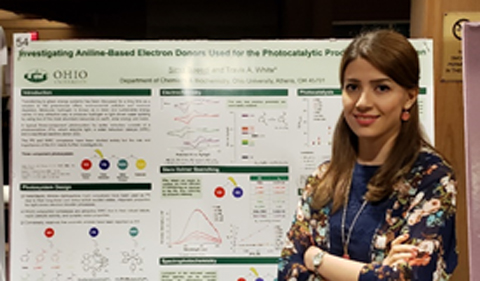Chemistry graduate student Sima Saeedi presented her research during the Ohio Photochemical Society 2019 meeting (OoPS 2019) and was awarded an “Outstanding Poster Award” out of 56 student contestants.
Saeedi is working in the research group of Dr. Travis A. White, Assistant Professor of Chemistry & Biochemistry at Ohio University.
Her research focuses on the development of copper-based visible light absorbers that function to photoinitiate electron transfer reactions with the aim of photocatalytically converting water into hydrogen gas. The work presented detailed her recent findings on modifying the electron donor source and the role it has on photocatalytic hydrogen evolution. Saeedi’s success at OoPS 2019 comes after her second place poster award in the Chemistry & Biochemistry graduate division at OHIO’s Student Expo in April 2019.
For more information regarding photocatalytic water reduction to hydrogen fuel, contact White at whitet2@ohio.edu.
Abstract for “Moving electrons and protons with visible light-absorbing heteroleptic Cu(I) photosensitizers:” Molecular hydrogen is known as a clean and sustainable energy carrier. A very attractive way to produce hydrogen is light driven water splitting by using two of the most abundant resources on earth, solar energy and water. A typical three-component photosystem for water reduction consists of a photosensitizer, which absorbs light, a water reduction catalyst and a sacrificial electron donor. Our group has recently studied and modified a photosystem which exploits heteroleptic diimine-diphosphine Cu(I) complexes as a photosensitizer and Rh(III) compounds as a water reduction catalyst. The heteroleptic Cu(I) photosensitizers are used due to their visible light-absorbing properties and Rh(III) catalysts are known for their robustness and high catalytic efficiencies. However, the sacrificial electron donor is another significant component of this photosystem and better understanding its contributions towards the water reduction process is important. In this work, hydrogen production using dimethyl aniline (DMA) as an electron donor has been investigated and compared to the structurally similar dimethyl toluidine (DMT) electron donor. Substituting the methyl groups at the ortho, meta and para positions and replacing it by more electron donating/withdrawing groups will provide information regarding steric and/or electronic influences.




















Comments